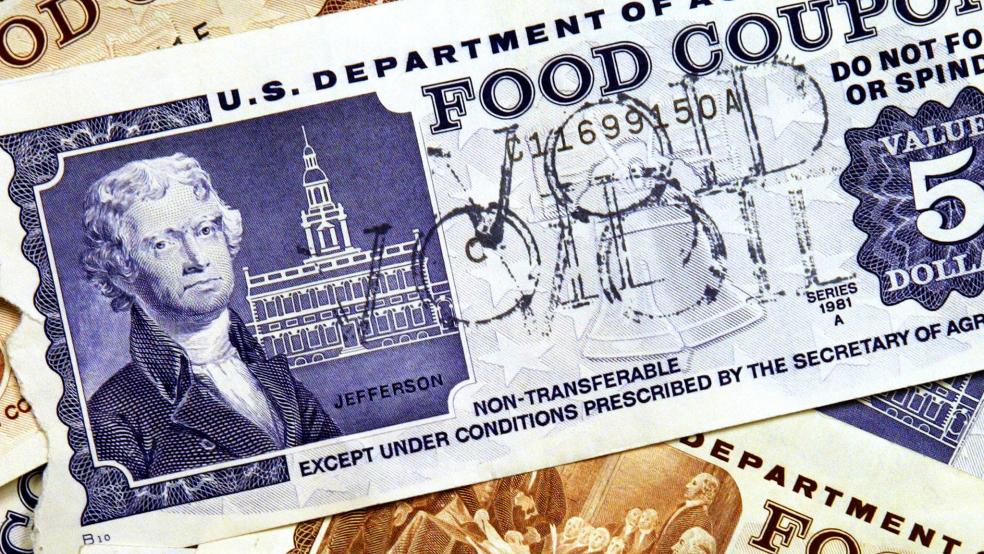Federal food stamp caseloads dropped 11 percent last year as the economy continued to improve. But some GOP lawmakers see the potential for further cuts to the $74 billion program, which has increased more than 45 percent since President Obama was sworn in.
The House Agriculture Committee on Wednesday kicked off a series of fact-finding hearings on the Supplemental Nutrition Assistance Program (SNAP). The committee’s new chair, Rep. Mike Conaway (R-TX), said, “We have seen the overall unemployment rate fall, yet the number of long-term unemployed remains high.”
Related: Food Stamp Use Plummets Amid Job Growth
“The lengthy ‘recovery’ following the 2009 recession has brought in a new group of healthy, working-age recipients, who in the past had not used SNAP,” Conaway said. “This is a new dynamic not previously experienced following other recessions when periods of unemployment were much shorter.”
Conaway said he’s launching a program review with no preconceived notions. There are a number of bipartisan work-requirement reforms enacted in the Agricultural Act of 2014, he noted, that have not been fully implemented and could help cull the rolls.
Rep. Jim McGovern (D-MA), a champion of SNAP, charged that Conaway and other Republicans have already decided to tighten regulations and cut food stamp spending – and are using the hearings as political cover, Politico reported. McGovern said the committee should examine new farm bill subsidies instead, which are projected to cost far more than anticipated.
The controversial food stamp program grew from a pilot program serving just 500,000 people in 1964 to a program that at its peak during the recession served over 47 million Americans.
Related: The Surprising Fact of Hunger in America
SNAP helps low-income Americans afford a nutritionally adequate diet by giving them benefits through a debit card that can be used only to purchase food. Actual benefits are relatively modest. SNAP households receive an average monthly benefit calculated by the cost of living in their state. Hawaii, for example, gets $443 per month, while Oregon households receive $215 on average.
While SNAP spending dropped to $74 billion last year, it soared from $21 billion in 2000 to $80 billion in 2013 when Americans were still struggling during the recession, experts note. The budget for SNAP was substantially bolstered in 2009 as part of the American Recovery and Reinvestment Act, while an additional $45.2 billion was authorized over four years, allowing SNAP to temporarily increase individual monthly benefits to an average of $133.
Beginning in November 2013, spending on federal food stamps was automatically cut by $5 billion – or 11 percent -- for the rest of the fiscal year and by additional amounts; that’s when the economy was continuing to improve and short-term loopholes were closed.
SNAP has been criticized by conservative Republicans and some government watchdog groups for excessive spending, fraud and abuse. The Obama administration responded to growing complaints in May 2012 by going after merchants and beneficiaries who trafficked in food stamp debit cards – a $750 million-a-year scam.
The news media highlighted cases of beneficiaries exchanging food stamps for cash and ineligible merchandise, such as cigarettes and liquor. There was also anecdotal evidence that college students from families with means were using food stamps to pay for pizza parties.
Related: Crackdown on Food Stamp Fraud: A $750M-a-Year Scam
Yesterday, Rep. David Rouzer (R-NC) said some of his constituents complained they’ve had to work to buy groceries while people who haven’t “contributed quite as much to society” are getting everything handed to them, Politico reported.
Robert Greenstein, president of the Center on Budget and Policy Priorities, testified that SNAP has played a central role in largely eliminating severe hunger and malnutrition in the U.S..
“SNAP can respond immediately to help families bridge temporary periods of unemployment or a family crisis,” he said in prepared testimony. “If a parent loses her job, SNAP can help her feed her children until she is able to improve her circumstances.”
A Department of Agriculture study of SNAP participation from 2008 to 2012 found that half of all new entrants participated for one year and then left the program when their needs passed. In January, CBO issued a new long-range budget analysis showing that while about 46 million people will use SNAP this year, the number will drop to 33 million by 2025, absent another economic downturn.
“I hope the committee will keep in mind the accomplishments the program has made and proceed with appropriate caution,” Greenstein added. “The well-being of millions of vulnerable Americans is at stake.”
Top Reads from The Fiscal Times:





